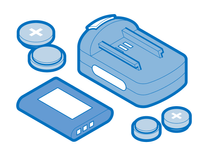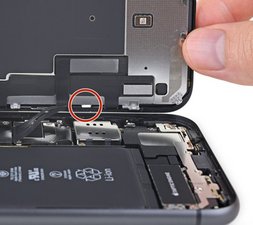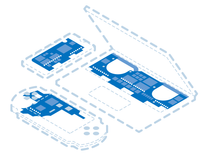First Steps
Before undertaking any of the more time consuming solutions below, there are a few fundamentals to get you started.
- Connect to a different, or known functional charger. Your phone may not be getting enough energy to complete boot.
- Perform a force restart. Consult the Guide for your model if you are not familiar with this process.
- If you can get into the OS, check for any software updates. This also includes app updates.
Causes
During the course of using your phone, something in the ones and zeroes that makes it run might have been lost, or changed in a way that renders your device unusable. This is commonly a result of a botched update, an app which conflicts with functionality, or even a malicious piece of software.
To attempt to correct this, perform a reinstall of the operating system. If your phone will stay booted for long enough, you can try this from within the settings menu. Otherwise, you'll need to get it into recovery mode to initiate this process.
- Try update first.
- If the update is unsuccessful, time to assess the state of your backups. If you're certain you have a recent backup, or are willing to sacrifice your data to regain use of your phone, proceed to restore. This will erase any data presently on your phone. If you would rather not erase the device, skip restore and try some of the fixes below first.
If the update or restore fails with an error message, document it. Now might be a good time to visit the Answers forum, where you can get more personalized help. Be sure to mention the error message in your question!

- 5 - 35 minutesVery easy
We are likely all aware that all rechargeable batteries degrade over time. Not only are the chemicals contained in them consumed with use, they can also fail suddenly. Both can lead to unexpected shutdowns.
- Check your battery health under Settings > Battery > Battery Health.
- By Apple’s guidelines, anything with a capacity of less that 80% needs battery service, though flat-out failures are also noted here. If the menu reads Service, a Apple iPhone Batteries is a reasonable start.
- See if Performance Management is enabled. This is turned on automatically if your phone has experienced unexpected shutdowns resulting from questionable battery health.

- Search for signs of battery swelling. Is there localized screen discoloration on the left side (or right side for series 12 and newer phones)? Is the screen lifting along one side?
- Replace the battery if there are any indications of failure. Exercise caution when handling the battery. Lithium-ion batteries can be hazardous if they are damaged.

Find compatible replacement parts for your Apple iPhone. All parts and fix kits are backed by the iFixit Quality Guarantee.
Starting with the iPhone X, Apple rolled out a sensor check routine as part of normal function. Any sensor in a predetermined list needs to send out a signal every 180 seconds, or the phone will restart as a protective measure.
- This is almost certainly the cause if your phone boots normally, but will only stay on for three minutes before restarting.
- Check the logs, a place iPhone owners seldom tread.
- Under Settings > Privacy > Analytics and Improvements > Analytics Data. Scroll through for any entries with panic or panic-full in the name.
- Find the panic string.
- Missing sensor errors will show as thermalmonitord or watchdog timeout. If your panic string is different, look for keywords to give you clues. For more info refer to the expanding page of panics. Or post in the answers forum for the community to look at!
- For a watchdog timeout or thermalonitord panic, read past the panic string to find the missing sensor.
- Reseat the connectors for the indicated parts. Inspect them for signs of damage or malfunction. Replace if necessary. Note: Be sure to source replacement parts from reputable vendors, or splurge for the higher quality part. Substandard third party replacements are rampant.
| Missing Sensor | Location | Likely Issue |
|---|---|---|
| PRS0 - Barometer | On the Charge Port Assembly | Charge Port Assembly or its connector on the Logic Board |
| Mic1 - Bottom Microphone | ||
| Mic2 - Rear Microphone | Power Button Cable, Camera Flash Cable | Power Button Cable, Camera Flash Cable or its respective connector on the Logic Board |
| TG0V | Battery sensors, most likely for temperature and voltage | Battery or its connector on the Logic Board, Charge Port Assembly on 11 Pro and Pro Max, charging circuitry on the board level. |
| TG0B |
Ultimately, nearly every signal within an iPhone is going to, or coming from within the board. Disruption of these necessary communications to connected hardware can also cause shut downs.
- Boot up on a minimal hardware configuration. Note: This method is a bit beyond what you may be willing to endeavor yourself since it is time consuming and may require a complete teardown of your phone. Seek the help of a capable technician if it sounds outside your capabilities.
- Open up the device and disconnect any connector not for display, battery or charge port.
- Connect a charger or USB cable to prompt the phone to boot.
- If the phone boots normally on the minimal setup, reconnect parts one by one. Be suspicious of the home button and front facing camera cables
- Replace the component which triggers the shutdown.
The best laid plans sometimes end with your phone in the toilet. Even if your phone seems perfectly fine, it might not be. It only takes one tiny droplet of water in the wrong place to wreak havoc on a circuit board.

- If there is any chance your phone may have gotten wet, check the liquid damage indicator.
- Eject your SIM tray and use a flashlight to peek inside. The liquid contact sticker is on the underside of the display. It can be tricky to spot, but it will be red if it has contacted liquid and white if it's dry.
- A red sticker isn't a guarantee that your phone is loaded with last night's cocktail, but it warrants further investigating. Open your device using the appropriate Guide and make use of the iPhone Liquid damage Guide if need be.
- If you subscribe to the leave it in rice myth—reevaluate! It might save your phone.

- 1 hourModerate
The logic board is the hub for the vast majority of an iPhone's functionality. Any number of the small components on the board may have failed or become damaged, and is a safe assumption of cause if nothing else on this page has worked.
- Check for obvious signs of a board issue - burned or cracked components, liquid residue, corrosion or bend.
- Replacing the logic board with a new one is often the most practical solution for a DIYer in this position.
- If you’re feeling especially curious, the tiny bits and chips on the board can be repaired by microsoldering. It is an art unto itself, but a worthy endeavor for those who are adventurous. Interested? Check out this intro! Jessa’s YouTube channel is also fantastic and has loads of real time repairs. If you can't do this sort of repair yourself, you may be able to find a local shop who can!

Find compatible replacement parts for your Apple iPhone. All parts and fix kits are backed by the iFixit Quality Guarantee.
You're seeing solutions for Apple iPhone. Select your model to find parts for your device.







